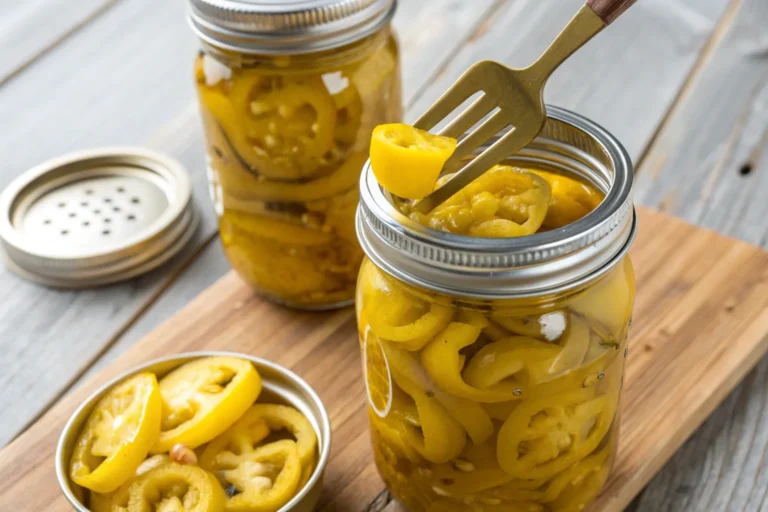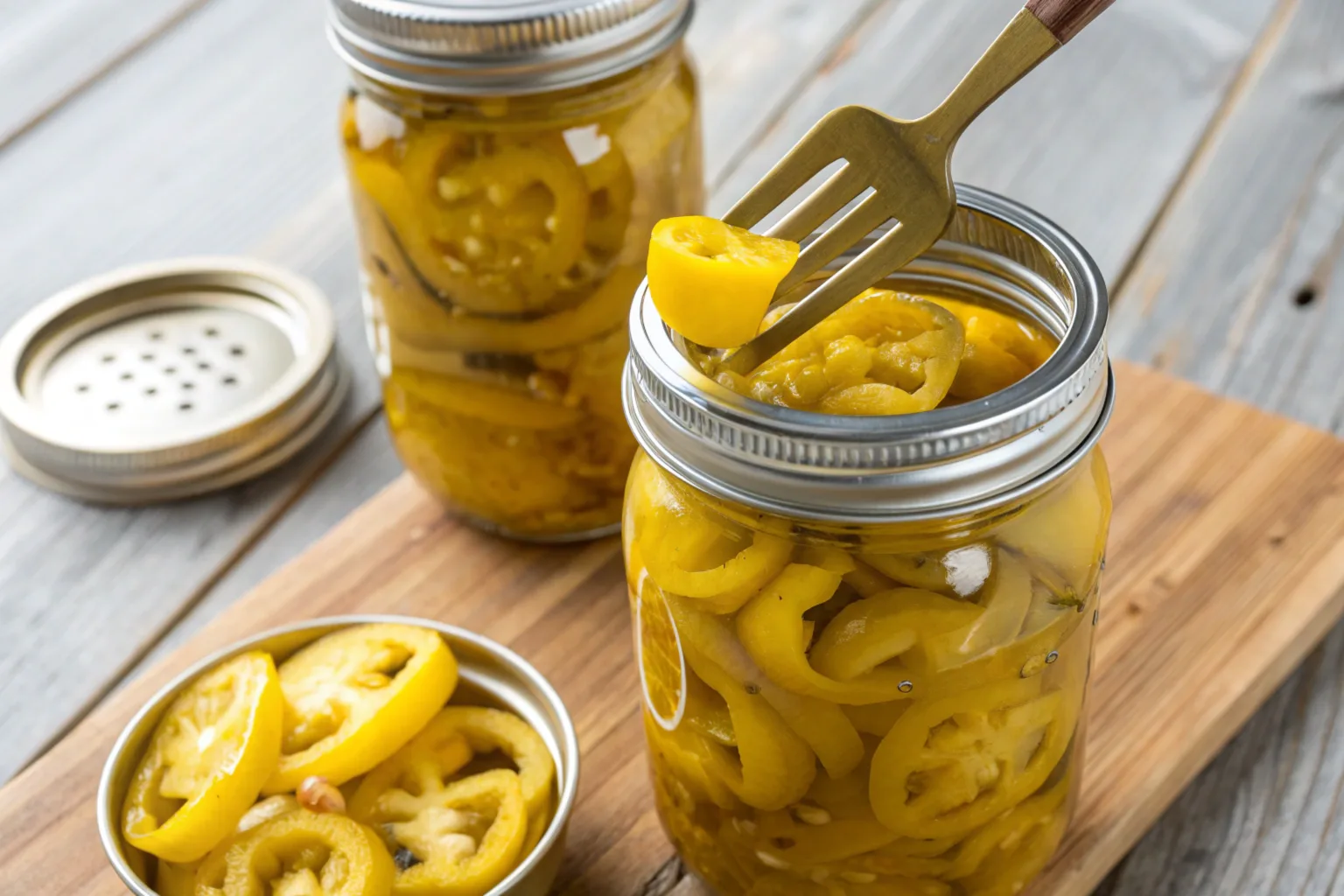Let’s talk about banana peppers, the unsung heroes of the pepper world. They’re mild, tangy, and incredibly versatile, making them a go-to ingredient for everything from salads to pizzas. But here’s the kicker—they’re not just tasty; they’re packed with nutrients and offer surprising health perks. Whether you’re a foodie looking for your next kitchen experiment or someone just trying to eat a little healthier, this article’s got you covered. We’ll dive into everything you need to know about these golden beauties, from their nutritional punch to how to grow your own. Ready? Let’s get started!
Table of Contents
Banana Peppers
What Are Banana Peppers?
Banana peppers—sometimes called yellow wax peppers—are a type of chili pepper with a unique look and flavor. They’re long, slender, and, you guessed it, shaped like bananas. With a bright yellow color that occasionally ripens to orange or red, these peppers are as appealing to the eyes as they are to the taste buds.
And the best part? They’re mild! On the Scoville scale (the fancy chart measuring pepper heat), they rank between 0 and 500 units. That’s just enough to add flavor without turning your mouth into a volcano.
Why Are They Called Banana Peppers?
Honestly, it’s all about appearances. These peppers’ elongated shape and sunny hue resemble—you guessed it—bananas! But don’t be fooled; they don’t taste fruity. Instead, their flavor is a mix of sweet and tangy, with just a whisper of spice.
So, the next time you spot banana peppers at the store, remember: they’re not bananas, but they’re still bananas good.
Nutritional Value of Banana Peppers
Nutritional Profile
Let’s get nerdy for a minute—banana peppers are a nutritional powerhouse in a tiny package. These little guys are low in calories (just 27 per 100 grams!) and completely fat-free, which makes them a guilt-free addition to any meal. Plus, they’re loaded with vitamins and minerals.
Here’s the highlight reel: they’re a rich source of Vitamin C, providing over 140% of your daily value in just one serving. That’s more than oranges, believe it or not! They also pack Vitamin A, which is great for keeping your vision sharp, and a bit of Vitamin B6, which helps keep your brain humming.
If that’s not enough, banana peppers are a solid source of dietary fiber. This means they not only taste great but also help keep your digestive system happy. Oh, and did I mention the potassium? It’s good for your heart and muscles.
Health-Boosting Compounds
Here’s where banana peppers get even cooler: they contain antioxidants, which help fight those pesky free radicals floating around in your body. (Think of them as little shields for your cells.)
Then there’s capsaicin, the compound responsible for their slight heat. It’s mild in banana peppers, but even a small amount has been linked to lowering blood pressure and improving heart health.
So, whether you’re tossing them in a salad or munching on them straight from the jar, you’re doing your body a solid.
Health Benefits of Banana Peppers
Immune System Support
Ever heard the saying, “An ounce of prevention is worth a pound of cure”? Well, eating banana peppers is like giving your immune system a little boost. Thanks to their high Vitamin C content, these peppers help your body fend off colds and infections. Vitamin C also helps your body absorb iron better, which is a big deal for keeping your energy levels up.
Plus, the antioxidants in banana peppers act like your personal bodyguards, protecting your cells from damage caused by stress, pollution, and aging.
Heart Health
You’ve probably heard that spicy foods can be good for your heart, right? Even though banana peppers are mild, they still contain a pinch of capsaicin. Studies have shown that capsaicin may help lower blood pressure, improve circulation, and reduce cholesterol. Combine that with the potassium in these peppers, and you’ve got a snack that’s practically heart-healthy.
Digestive Health
Let’s talk fiber—it’s not glamorous, but it’s essential. Banana peppers provide a decent dose of it, which helps keep your digestive system running smoothly. If you’re someone who struggles with irregularity, adding more fiber to your diet can make a big difference.
And here’s a fun fact: the tangy flavor of banana peppers may stimulate saliva production, which is the first step in digestion. So, the next time you’re biting into one, know that your stomach is already saying “thank you!”
Weight Management
Trying to cut back on calories but still want your food to taste good? Banana peppers are a dream come true. They’re low-calorie, fat-free, and loaded with flavor, so they add excitement to meals without packing on the pounds. Whether you’re on a diet or just trying to eat smarter, they’re a perfect fit.
Culinary Uses of Banana Peppers
Raw in Salads and Sandwiches
If you’re looking to add a zesty twist to your meals, banana peppers are perfect for the job. Their crisp texture and tangy flavor make them a natural fit for salads and sandwiches. Picture this: a turkey sandwich loaded with fresh greens, creamy mayo, and a few slices of banana peppers for that extra kick. Sounds good, right?
In salads, they pair well with ingredients like feta cheese, olives, and cucumbers. Toss them into a Greek salad or use them as a topping for a classic Caesar—either way, you can’t go wrong.
Cooking Applications
These peppers aren’t just for raw munching—they shine in cooked dishes too! Stuff them with a mix of ground meat, rice, and cheese for a hearty appetizer. Or throw them on a pizza for a tangy contrast to melted mozzarella.
For something quick and flavorful, try sautéing banana peppers with garlic and olive oil as a side dish. It’s simple, but trust me, it’s a game-changer.
Looking for more ideas? For delicious recipes like these, check out Eminent Recipes for their creative twists on everyday meals.
Preserving Banana Peppers
Pickling banana peppers is a fantastic way to enjoy their tangy flavor year-round. All you need are vinegar, sugar, and a few spices. Once pickled, they’re a great addition to burgers, tacos, or charcuterie boards.
Not into pickling? No problem. Fresh banana peppers can be stored in the fridge for up to a week. For longer storage, freeze them whole or sliced—they’ll keep their flavor for months.
How to Grow and Harvest Banana Peppers
Planting Basics
Growing banana peppers at home is a rewarding experience, and it’s easier than you’d think! Start with good-quality seeds or seedlings from a trusted source. If you’re a newbie, seedlings are a great option—they give you a head start and are less finicky than seeds.
Timing is everything with these sun-loving plants. Banana peppers thrive in warm weather, so wait until the last frost has passed before planting them outdoors. A sunny day in late spring or early summer is ideal. If you’re in a colder region, consider starting seeds indoors about 8–10 weeks before the last frost.
When it comes to soil, these peppers aren’t too picky, but they do best in well-draining, nutrient-rich soil. If you’re planting directly in your garden, loosen the soil and mix in some compost or organic matter for added nutrients. For container gardening, use a high-quality potting mix.
Pro tip: If you’re new to growing peppers or short on garden space, planting banana peppers in pots is a fantastic idea. They’re manageable, portable, and perfect for patios or balconies.
Caring for Banana Pepper Plants
Banana peppers are low-maintenance, but they do have a few must-haves to keep them thriving.
Watering:
Consistency is key. Peppers like to stay evenly moist but not soggy. Water them deeply once or twice a week, depending on your climate. During hot or dry spells, you might need to water more often, but always let the top inch of soil dry out between watering to avoid overwatering.
Feeding:
Banana peppers are light feeders but benefit from a balanced fertilizer every 2–3 weeks. Look for one labeled for vegetables or peppers, with a good mix of nitrogen, phosphorus, and potassium. If you’re into organic gardening, compost tea or fish emulsion works wonders too.
Sunlight:
These peppers are sun worshippers. Make sure they get at least 6–8 hours of direct sunlight daily. If you notice your plants looking leggy or pale, they might need more sun.
Support:
As banana pepper plants grow, their branches may need a little help holding up heavy peppers. Use stakes or cages to provide support and prevent the stems from bending or breaking.
Managing Pests and Diseases
Like all plants, banana peppers have their share of potential pests and diseases, but with some vigilance, you can keep issues at bay.
Common Pests:
- Aphids: Tiny, sap-sucking bugs that can cluster on leaves. Blast them off with a strong spray of water or treat with insecticidal soap.
- Spider Mites: These minuscule pests can create webs on plants. Neem oil is a great natural remedy.
- Pepper Weevils: These guys target the fruit. Hand-picking and discarding infected peppers can minimize damage.
Disease Prevention:
To avoid fungal diseases like blight or powdery mildew, water your plants at the base rather than overhead. Good air circulation around your plants also helps keep them healthy. Rotate your crops each year to reduce the risk of soil-borne diseases.
Harvesting Tips
Now for the exciting part—harvesting! The trick is knowing when your banana peppers are at their peak.
When to Harvest:
Banana peppers are typically ready to pick when they turn bright yellow and reach about 4–6 inches in length. If you prefer a sweeter flavor, leave them on the plant a bit longer to ripen to orange or red.
Harvesting at the right time not only gives you the best flavor but also encourages the plant to produce more peppers. Win-win!
How to Harvest:
Always use scissors or a sharp knife to cut the peppers from the plant. Tugging or pulling can damage the stems and reduce future yields. Hold the pepper gently and cut the stem about an inch above the fruit.
After Harvesting:
Once you’ve picked your peppers, give them a rinse and store them in the fridge. They’ll stay fresh for about a week. For longer storage, consider freezing them whole or sliced.
Making the Most of Your Harvest
Once you’ve got your fresh banana peppers, the possibilities are endless! They’re perfect for pickling, stuffing, or adding to salads, sandwiches, and pizzas. Want to try something new? For step-by-step recipes and ideas, check out Eminent Recipes.
Growing and harvesting banana peppers is not only fun but also a fantastic way to enjoy fresh, flavorful produce. With a little care and attention, your plants will reward you with an abundant, delicious harvest. Enjoy the fruits of your labor!
FAQs:
Are Banana Peppers Spicy?
Nope, not really! While banana peppers are technically a type of chili pepper, they’re on the milder side of the Scoville scale, usually clocking in at 0–500 units. For comparison, jalapeños can go up to 8,000! Their mild heat makes them a favorite for those who enjoy flavorful but not-too-spicy foods.
If you’re feeling adventurous, let them ripen longer on the plant—they’ll develop a slightly sweeter and richer flavor.
Can Banana Peppers Help With Weight Loss?
Absolutely! These peppers are low in calories, with just 27 calories per 100 grams. They’re also fat-free, making them a perfect choice for anyone watching their waistline. Plus, their tangy taste can help you cut back on heavy dressings or sauces.
Snack on pickled banana peppers or toss them into your meals for extra flavor without the guilt.
What’s the Best Way to Cook Banana Peppers?
There’s no wrong way! You can stuff them, sauté them, grill them, or even pickle them. One popular option is stuffing them with cheese or ground meat, then baking until golden and bubbly. (It’s as tasty as it sounds!)
For more ideas, check out creative recipes on Eminent Recipes.
Are There Any Side Effects to Consuming Banana Peppers?
For most people, banana peppers are perfectly safe and healthy. However, if you have a sensitive stomach, eating too many may cause mild digestive discomfort due to their natural acidity. If you’re unsure, start with small portions and see how your body reacts.
Conclusion:
Banana peppers are a little fruit with big possibilities. Whether you’re adding a tangy crunch to your salads, spicing up your sandwiches, or growing them in your garden, these vibrant peppers deliver on flavor and nutrition.
Packed with Vitamin C, fiber, and antioxidants, they’re a simple way to boost your health without sacrificing taste. Their mild heat makes them accessible to almost everyone—kids, spice newbies, and seasoned foodies alike.
So, next time you’re at the store (or in your garden), don’t overlook these golden beauties. And if you’re itching to try some creative recipes, you know where to look—Eminent Recipes has your back.
With banana peppers, the possibilities are endless—and delicious!
Print
Banana Peppers
Stuffed Banana Peppers are a flavorful and versatile dish perfect as an appetizer or a main course. Filled with a savory mixture of cheese and seasonings, these peppers are baked to perfection with just the right balance of heat and creaminess.
Ingredients
- 6 banana peppers
- 1 cup cream cheese, softened
- 1/2 cup shredded mozzarella cheese
- 1/4 cup Parmesan cheese, grated
- 1 teaspoon garlic powder
- 1/2 teaspoon onion powder
- 1/2 teaspoon Italian seasoning
- 1/4 teaspoon red pepper flakes (optional, for extra heat)
- Salt and pepper to taste
- 1 tablespoon olive oil
Instructions
- Preheat Oven: Preheat your oven to 375°F and line a baking sheet with parchment paper.
- Prepare Peppers: Cut a slit down the length of each banana pepper and carefully remove the seeds and membranes. Be cautious not to tear the pepper.
- Make Filling: In a bowl, mix cream cheese, mozzarella cheese, Parmesan cheese, garlic powder, onion powder, Italian seasoning, red pepper flakes (if using), salt, and pepper until smooth.
- Stuff Peppers: Spoon the cheese mixture into each banana pepper, packing it in gently.
- Bake: Place the stuffed peppers on the prepared baking sheet and drizzle with olive oil. Bake for 20-25 minutes, or until the peppers are tender and the filling is golden and bubbly.
- Serve: Let cool for 5 minutes before serving. Enjoy as is or with a side of marinara sauce for dipping.
Notes
- Milder Option: If you prefer less heat, use sweet banana peppers instead of hot ones.
- Protein Addition: Mix in cooked ground chicken, turkey, or beef with the cheese filling for a heartier dish.
- Grilling Option: Instead of baking, grill the stuffed peppers over medium heat for 8-10 minutes, turning occasionally.
- Make Ahead: Assemble the stuffed peppers and refrigerate for up to 1 day before baking.

